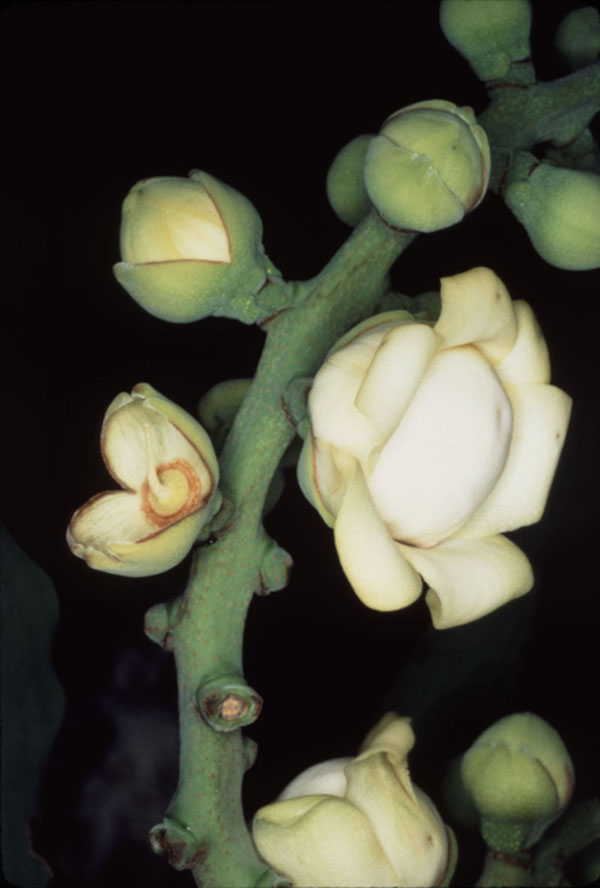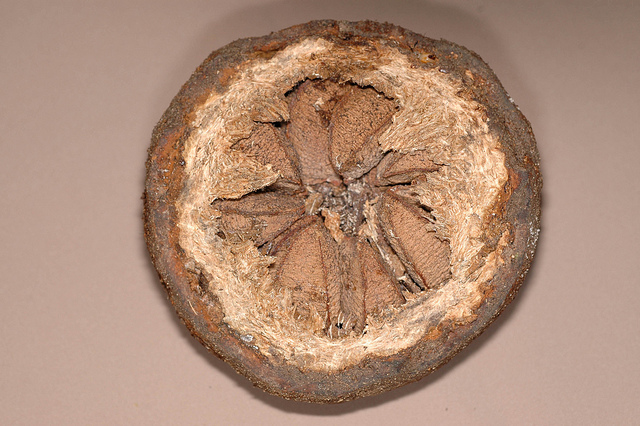Reproduction
B. excelsa is a member of the angiosperms, which is a group
of seed plants that develop flowers and fruiting bodies to cover
their seeds. The flower of B. excelsa is zygomorphic,
which means that it only has a single plane of symmetry dividing
the
flower into two equal halves. What makes the flower of B.
excelsa interesting is the fact that very few organisms can
actually pollinate it due to the petals being tightly pressed
against the androecium. This seal can only be broken by
organisms that are small enough to fit on the flower, but strong
enough to pry their way in. The most common organism to
pollinate the flower is an orchid bee (many different species
found throughout multiple genera). Similar to many
flowering plants, the pollinator (in this case, the orchid bee)
feeds on the nectar within the flower, which consequently leads
to the bee picking up the flower's pollen. Eventually, the pollen will
make its way to the flower of a different B. excelsa tree,
completing the pollination stage of the life cycle.
zygomorphic,
which means that it only has a single plane of symmetry dividing
the
flower into two equal halves. What makes the flower of B.
excelsa interesting is the fact that very few organisms can
actually pollinate it due to the petals being tightly pressed
against the androecium. This seal can only be broken by
organisms that are small enough to fit on the flower, but strong
enough to pry their way in. The most common organism to
pollinate the flower is an orchid bee (many different species
found throughout multiple genera). Similar to many
flowering plants, the pollinator (in this case, the orchid bee)
feeds on the nectar within the flower, which consequently leads
to the bee picking up the flower's pollen. Eventually, the pollen will
make its way to the flower of a different B. excelsa tree,
completing the pollination stage of the life cycle.
Once fertilization is complete, the seeds and tough fruiting body start to
develop. After approximately fifteen months of development,
the Brazil nut fruit is fully
developed.
The fruit falls from the tree in an attempt to disperse the seeds; however, the fruit structure of B. excelsa is extremely tough
and thick, so the fall from the tree is not enough to break open the
fruit. The tough fruit is what makes seed dispersal such a complex process
because it requires aid from another organism to get through the
shell.
This problem is solved by the intervention of a rodent, usually
an agoutis, strong enough to chew through the shell and get
to the seeds. After acquiring the seeds, the rodent stores
any uneaten seeds by burying them. Once buried, the seeds are
free to grow and complete the B. excelsa life cycle.
however, the fruit structure of B. excelsa is extremely tough
and thick, so the fall from the tree is not enough to break open the
fruit. The tough fruit is what makes seed dispersal such a complex process
because it requires aid from another organism to get through the
shell.
This problem is solved by the intervention of a rodent, usually
an agoutis, strong enough to chew through the shell and get
to the seeds. After acquiring the seeds, the rodent stores
any uneaten seeds by burying them. Once buried, the seeds are
free to grow and complete the B. excelsa life cycle.
To learn more, continue to the Interactions page!